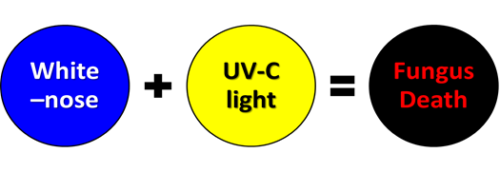 Purdue University - Extension - Forestry and Natural Resources
Purdue University - Extension - Forestry and Natural Resources
Got Nature? Blog
White-nose syndrome is a fatal disease that has devastated bat populations in parts of the United States and Canada. In a recent study published by the USDA Forest Service Northern Research Station, a surprising result regarding treatment and eradication of Pseudogymnoascus destructans, the psychrophilic fungus that causes white-nose syndrome, was obtained. When exploring the disease using genetic methods, it was noted that exposure to UV-light kills Pseudogymnoascus destructans.
The primary scientists involved in these studies are USDA scientists Jon Palmer (Research Botanist based in Madison, WI) and Daniel Lindner (Research Plant Pathologist based in Madison, WI) and University of New Hampshire scientists Kevin P. Drees and Jeffery T. Foster. These scientists initially noted P. destructans only infected bats during hibernation because the fungus has rigid temperature requirements for growth 39-68 °F. It was later noted that the fungus is unable to repair DNA damage done by UV light. This early study was funded by the US Fish and Wildlife Service and published in Nature Communications. It went on to explain that the fungus likely evolved with bat species in Europe and Asia allowing them to evolve defenses against the fungus while American bats have no defense. However, a moderate dose of UV-C light for a few seconds results in <1% survival of the fungus.
Research on this topic is ongoing, with additional funds provided by Bats for the Future to examine survival of little brown bat colonies exposed to UV-C light during hibernation compared to unexposed colonies. The study will also examine potential non-target effects such as changes in bat skin microbes and bacteria. This breakthrough could lead to the long-term survival of our bat colonies.
References
Online article: https://www.sciencedaily.com/releases/2018/01/180102153209.htm
Publication: Jonathan M. Palmer, Kevin P. Drees, Jeffrey T. Foster, Daniel L. Lindner. Extreme sensitivity to ultraviolet light in the fungal pathogen causing white-nose syndrome of bats. Nature Communications, 2018; 9 (1) DOI: 10.1038/s41467-017-02441-z
Previous GotNature article: https://ag.purdue.edu/fnr/GotNature/Lists/Posts/Post.aspx?ID=238.
Resources:
Night Time is the Right Time to Look for Bats, Research on White Nose Syndrome – Dr. Pat Zollner
Shaneka Lawson, USDA Forest Service/HTIRC Research Plant Physiologist/Adjunct Assistant Professor
Purdue University Department of Forestry and Natural Resources

Recent Posts
- Publication – Introduction to White-tailed Deer Impacts on Indiana Woodlands
Posted: April 28, 2024 in Forestry, Land Use, Plants, Publication, Wildlife, Woodlands - Publication – Understanding White-tailed Deer and Their Impact on Indiana Woodlands
Posted: in Forestry, Land Use, Plants, Publication, Wildlife, Woodlands - Publication – Monitoring White-tailed Deer and Their Impact on Indiana Woodlands
Posted: in Forestry, Land Use, Plants, Publication, Wildlife, Woodlands - Publication – Managing White-tailed Deer Impacts on Indiana Woodlands
Posted: in Forestry, Land Use, Plants, Publication, Wildlife, Woodlands - Report Spotted Lanternfly – Purdue Landscape Report
Posted: April 10, 2024 in Alert, Forestry, Invasive Insects, Plants, Wildlife, Woodlands - Declining Pines of the White Variety – Purdue Landscape Report
Posted: in Alert, Disease, Forestry, Plants, Wildlife, Woodlands - Are you seeing nests of our state endangered swan? – Wild Bulletin
Posted: April 9, 2024 in Alert, Forestry, How To, Wildlife - Cicadas in Spring! – Purdue Landscape Report
Posted: in Forestry, Plants, Safety, Wildlife - New Deer Impact Toolbox
Posted: April 7, 2024 in Forestry, Land Use, Plants, Publication, Safety, Wildlife, Woodlands - 2024-25 Fishing Guide now available – Wild Bulletin
Posted: April 4, 2024 in Alert, Aquaculture/Fish, Aquatic/Aquaculture Resources, How To, Ponds, Wildlife
Archives
Categories
- Alert
- Aquaculture/Fish
- Aquatic/Aquaculture Resources
- Ask the Expert
- Christmas Trees
- Community Development
- Disease
- Drought
- Forestry
- Forests and Street Trees
- Gardening
- Got Nature for Kids
- Great Lakes
- How To
- Invasive Animal Species
- Invasive Insects
- Invasive Plant Species
- Land Use
- Natural Resource Planning
- Nature of Teaching
- Plants
- Podcasts
- Ponds
- Publication
- Safety
- Timber Marketing
- Uncategorized
- Urban Forestry
- Webinar
- Wildlife
- Wood Products/Manufacturing
- Woodland Management Moment
- Woodlands

